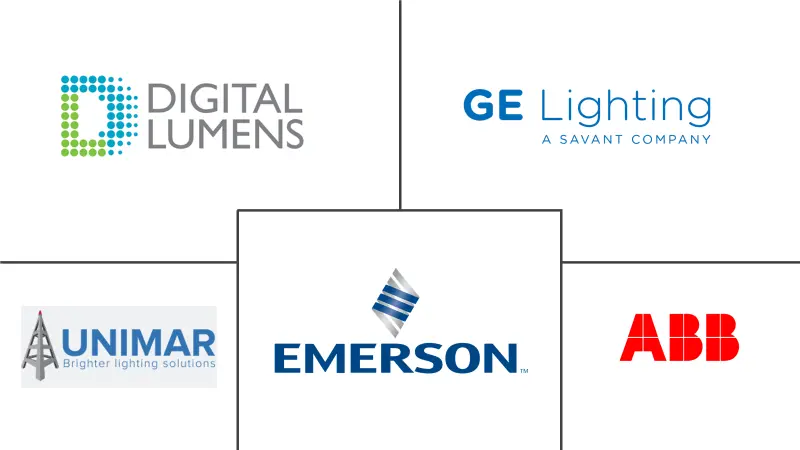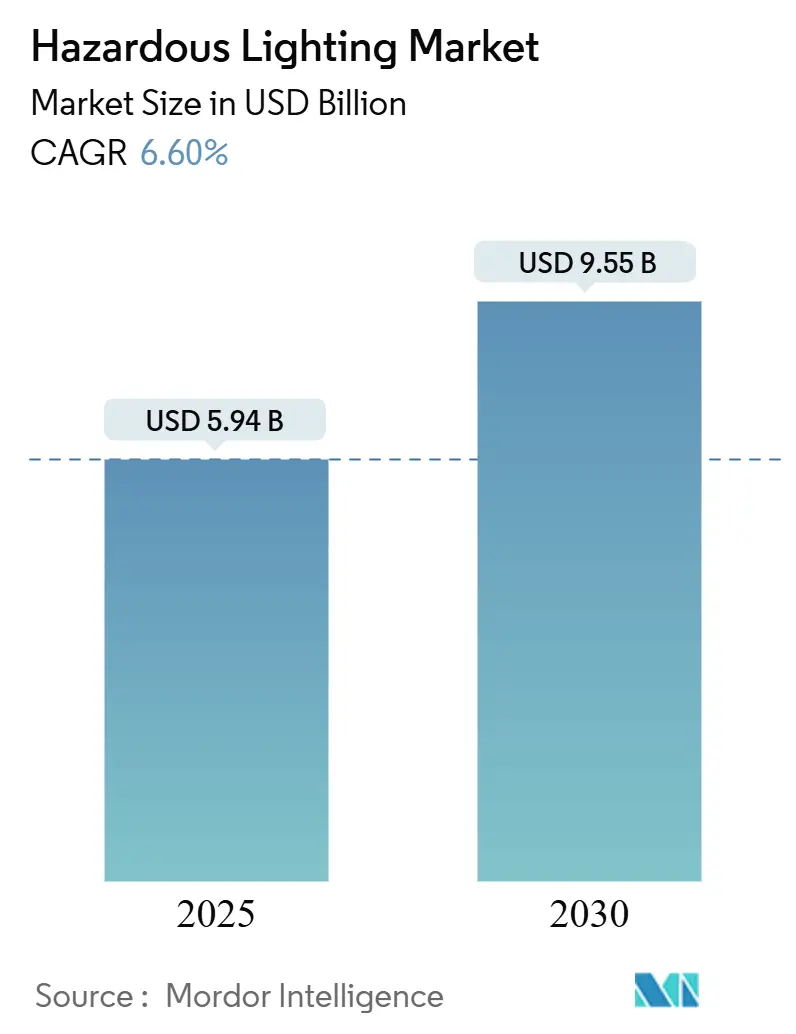
Hazardous Lighting Market Analysis by Mordor Intelligence
The Hazardous Lighting Market size is estimated at USD 5.94 billion in 2025, and is expected to reach USD 9.55 billion by 2030, at a CAGR of 6.60% during the forecast period (2025-2030).
- As technology evolves and safety regulations become more stringent, the hazardous lighting market is experiencing significant growth. The surge in automation and the Industrial Internet of Things (IIoT) has led to a heightened demand for smart hazardous lighting solutions owing to various benefits associated.
- Appropriate workplace lighting boosts employee performance, motivation, and overall well-being. This holds true for both shift workers in expansive industrial bays and those in specialized manufacturing zones. When utilized effectively, cutting-edge lighting solutions can optimize workstation conditions in manufacturing bays, enhancing motivation, reducing fatigue, and consequently, minimizing industrial accidents.
- The replacement of traditional flouroscent lighting systems with LEDs has been further driving the market due to their ability to dramatically reduce energy consumption. Moreover, their disposal contains less hazardous effects, as they contain no hazardous chemicals.
- Regulatory standards promoting the use of lighting are driving the market, as industry and regulatory standards define the criteria for designating a work area as a hazardous location and atmosphere around an industrial or manufacturing facility. The hazards may include concentrations of flammable vapors, dust, or fibers, which increase the demand for lighting that contains light fixtures with stronger housing and tempered glass, which encase sparks and other potential ignition sources away from a flammable substance.
- The mining industry is also expected to fuel the market for hazardous lighting. For instance, the United States government announced a Federal Strategy to ensure a reliable supply of critical minerals. This strategy led the US Department to locate the domestic supplies of essential minerals, start the production of these minerals, and gain permits for the expedition for minerals projects.
- However, rising environmental concern is restraining the market, as diode lighting quality significantly depends on the ambient operating temperature. Changes in the parameters of the current passing through the semiconductor elements at high temperatures can lead to burning out the module, especially LED. This issue affects the places and surfaces exposed to rapid increases in temperature or very high temperatures (steel mills).
Global Hazardous Lighting Market Trends and Insights
LED Lighting to Account for Significant Market Share
- Regulatory standards promoting LED lighting use, ensuring worker safety in hazardous locations, halting the use of mercury vapor ballasts and metal halide lighting, and the demand for cost-effective, long-lasting lighting solutions are driving market growth. As LED lighting emerges as a viable alternative to conventional systems, it presents global growth opportunities.
- In a significant move towards sustainability, the UK Government announced a phased ban on T5, T8, and compact fluorescent lighting in September 2023. This decision aligns with the EU Commission's updated Restriction of Hazardous Substances (RoHS) Directive, highlighting the UK's dedication to human health and eco-friendly lighting. Yet, many growth chambers and controlled environment facilities across the UK and Europe still depend on fluorescent tubes. Organizations are urged to assess their lighting sources and transition to LEDs.
- Due to their energy efficiency, durability, and instant illumination, LED lighting technology is the preferred choice for hazardous environments. Such lighting can significantly reduce operating and maintenance costs for facility operators. Rated for areas with flammable gases and vapors, LED luminaires meet conditions set by NEC Class I, Division 2, and IEC Zone 2.
- Additionally, LEDs emit no harmful ultraviolet or infrared radiation. This advantage translates to reduced cooling costs, easier maintenance, extended product life, protection for eyes and sensitive equipment, and enhanced safety in hazardous settings.
- Post the Chilean mining disaster, which saw 33 miners trapped 700 meters underground, the world spotlighted the daily risks miners face. In response, mining companies are increasingly adopting LED light bulbs to bolster safety in their operations.
- LEDs stand out for their ability to combat light pollution. By precisely controlling each diode's direction through lensing, LEDs can reduce light pollution by up to 50% and energy waste by a staggering 70%.
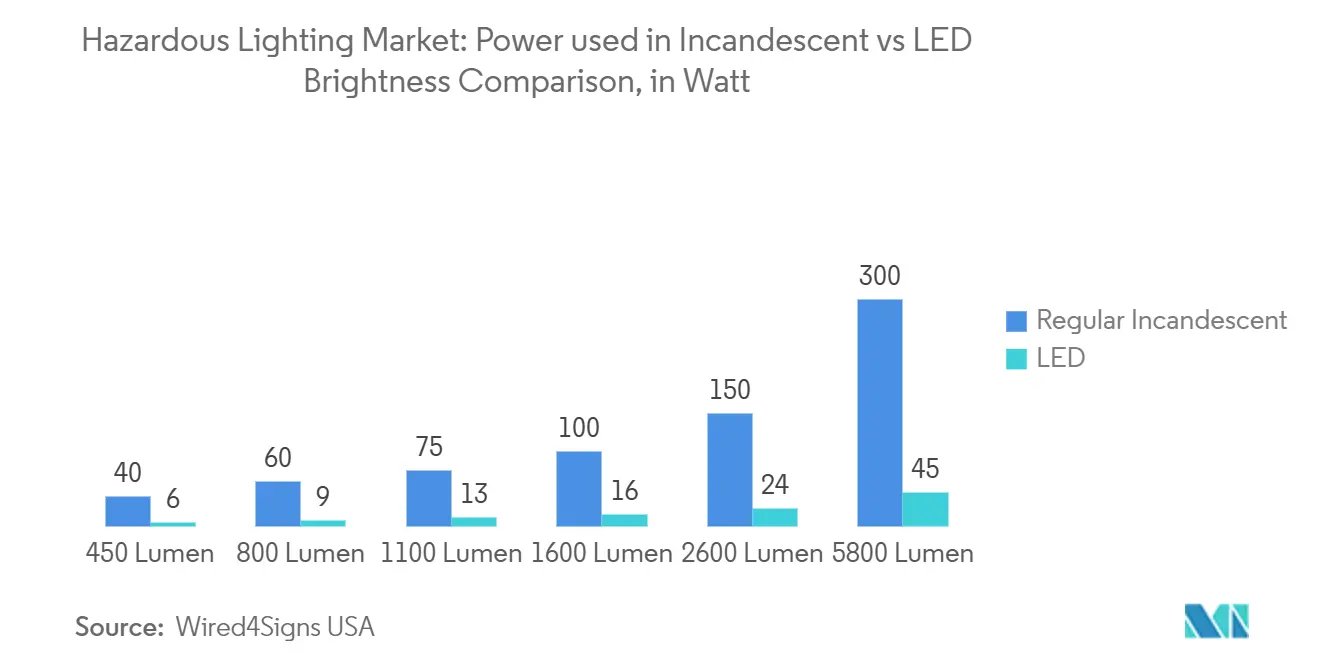
Asia-Pacific to Gain Significant Market Share
- Asia-Pacific is poised to dominate the market share, driven by the region's robust industrial and infrastructure growth and a rising demand for energy-efficient lighting in hazardous industrial settings.
- Over the past few years, the APAC region has emerged as a hub for pharmaceutical contract manufacturing. This evolution has not only transformed the nature and approach of contract manufacturing but also the distribution of drug products. Historically, medicines produced in the APAC region were predominantly for local consumption.
- In April 2024, Aurigene Pharmaceutical Services, a Dr. Reddy’s Laboratories subsidiary, unveiled ambitious plans for a biologics expansion over the next three years. Kicking off this initiative, the company is establishing a facility in Genome Valley, Hyderabad, focusing on therapeutic proteins, antibodies, and viral vectors, marking its entry into the biotech drug contract development and manufacturing arena.
- According to Invest India, India's pharmaceutical industry is on track to hit USD 130 billion by 2030. As a major player in the global pharmaceutical landscape, India caters to over 50% of Africa's generic needs, about 40% of the U.S. demand, and roughly 25% of the UK's medicine requirements. Additionally, India meets around 60% of the global vaccine demand and is a primary supplier of DPT, BCG, and Measles vaccines. Such robust trends are set to propel the growth of hazardous lighting in the coming years.
- China's push for self-sufficiency in petrochemicals is not only reshaping global oil demand but also attracting multinational companies eager to tap into the world's largest consumer market. With 305 petrochemical plants slated for completion by 2030, boasting a combined capacity of 152.4 mtpa, and major contributions from Hengli Petrochemical and China Petrochemical Corp, China's demand for hazardous lighting, particularly LED, is surging.
- Australia's mining sector, buoyed by robust resources and energy exports, is witnessing a lighting surge due to heightened mining activities. Exports Finance Australia highlights a consistent rise in mining investments, with the sector injecting USD 11.5 billion in Q1 2024—a 6% increase from last year and a striking 60% jump from Q1 2019. Looking ahead, FY2024 projections estimate total investments in the mining industry to reach a substantial USD 53 billion.
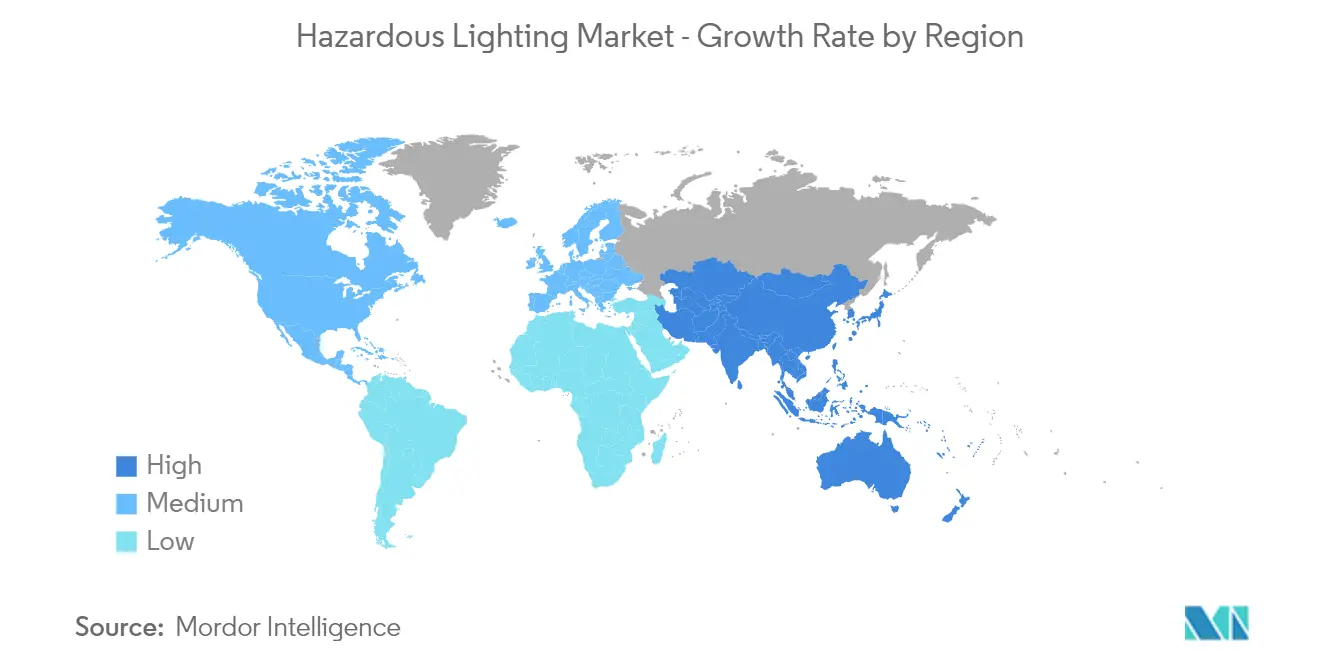
Competitive Landscape
The hazardous lighting market is highly fragmented, as players in the market continuously strive to maintain a competitive edge. The competition in the market studied is high due to the different levels of technical management and production management of the players in the market. The key players are Thomas & Betts Corporation (ABB Ltd), Emerson Industrial Automation, Digital Lumens Inc., etc.
Lighting technology is poised for a transformation in hazardous areas, driven by trends like IoT, smart lighting, and breakthroughs in explosion-proof lighting. As these innovations progress, they promise to bolster safety and efficiency in perilous settings.
Furthermore, the increasing focus on energy efficiency is driving the popularity of RoHS and LED Lighting. For instance, In 2007, the European Commission first imposed a ban on halogen lamps. More recently, both the European Union and the UK government announced RoHS2 (Restriction of Hazardous Substances). These moves have spotlighted LEDs, positioning them as the prime alternative to incandescent lighting due to their sustainability and energy efficiency. This directive not only guides the future use of lighting products but also presents a significant growth opportunity for LEDs.
Hazardous Lighting Industry Leaders
-
Thomas & Betts Corporation (ABB Ltd)
-
Emerson Industrial Automation
-
Digital Lumens Inc.
-
Unimar Inc.
-
GE Lighting LLC
- *Disclaimer: Major Players sorted in no particular order
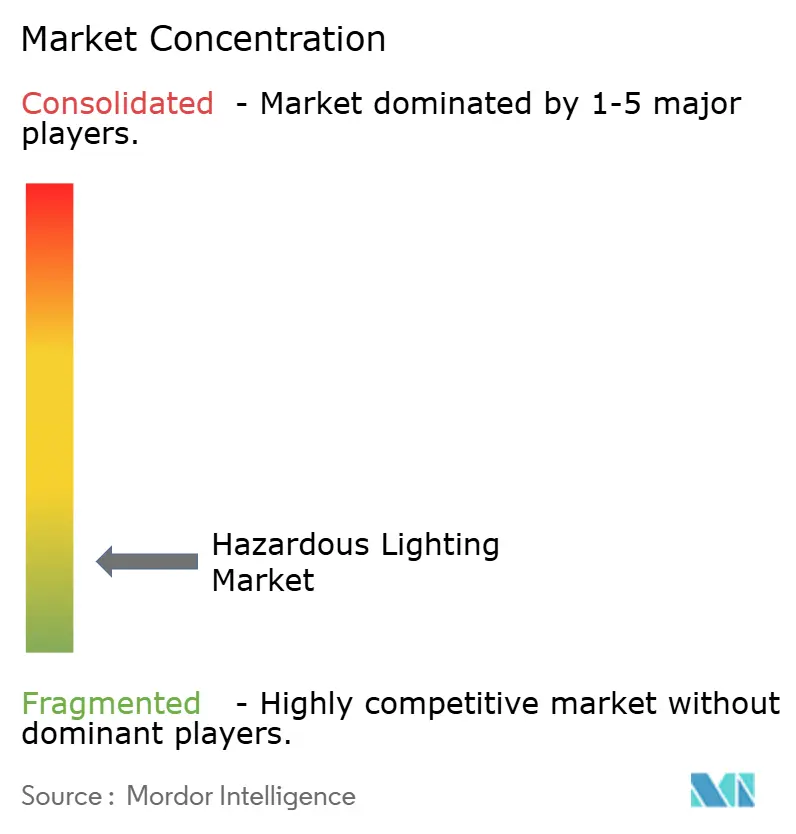
Recent Industry Developments
- April 2025: Wolf Safety has unveiled the TY-300, a cutting-edge handheld ATEX LED inspection light. This new device is engineered to excel in environments with potential explosive hazards. The TY-300 boasts certifications for operation in Zones 1 and 2 (gas) and Zones 21 and 22 (dust). Leveraging patented Directional Linear Optics (DLO) technology, it emits a powerful 1,390 lumens of low-glare illumination. Its compact and lightweight design makes it perfect for close inspections and temporary lighting tasks, and the integrated swivel hooks offer versatile suspension options.
- December 2024: Dialight has unveiled its latest innovation, the ProSite Streetlight. This cutting-edge fixture caters to both hazardous and non-hazardous settings, merging features from the former StreetSense range while enhancing performance and energy efficiency. The ProSite Streetlight not only brightens worksites but also aids workers in navigating them safely, highlighting potential risks before they escalate. Offering a lumen output between 12,000 and 30,000 and wattage choices from 80W to 235W, the ProSite Streetlight achieves an impressive illumination efficiency of up to 150 lumens per watt. Additionally, this model boasts various optical patterns and color temperatures, catering to a wide array of lighting requirements.
Global Hazardous Lighting Market Report Scope
Specialized lighting fixtures, known as hazardous lighting, are crafted for environments where flammable materials, such as gases, vapors, or dust, pose a risk of fire or explosion. Engineered to endure harsh conditions and avert ignition, these fixtures play a crucial role in ensuring safety across industries, including oil and gas, chemical processing, and manufacturing.
The report tracks the revenue generated from the sale of hazardous lighting across all the regions in end-user industries which include oil and gas, power generation, pharmaceutical and other end user industries.
The hazardous lighting market is segmented by type (LED lighting, incandescent lighting, HID lighting, and fluorescent lighting), class (class I, class II, and class III), hazardous zone (zone 0, zone 20, zone 1, zone 21, zone 2, and zone 22), end-user industry (oil and gas, power generation, chemical and petrochemical, pharmaceutical, and others), and geography. The market sizes and forecasts are provided in terms of value in USD for all the segments.
| LED Lighting |
| Incandescent Lighting |
| HID Lighting |
| Fluorescent Lighting |
| Other Types |
| Class I |
| Class II |
| Class III |
| Zone 0 |
| Zone 20 |
| Zone 1 |
| Zone 21 |
| Zone 2 |
| Zone 22 |
| Oil and Gas |
| Power Generation |
| Chemical and Petrochemical |
| Pharmaceutical |
| Other End-user Industries |
| North America |
| Europe |
| Asia-Pacific |
| Latin America |
| Middle East & Africa |
| By Type | LED Lighting |
| Incandescent Lighting | |
| HID Lighting | |
| Fluorescent Lighting | |
| Other Types | |
| By Class | Class I |
| Class II | |
| Class III | |
| By Hazardous Zone | Zone 0 |
| Zone 20 | |
| Zone 1 | |
| Zone 21 | |
| Zone 2 | |
| Zone 22 | |
| By End-user Industry | Oil and Gas |
| Power Generation | |
| Chemical and Petrochemical | |
| Pharmaceutical | |
| Other End-user Industries | |
| By Geography | North America |
| Europe | |
| Asia-Pacific | |
| Latin America | |
| Middle East & Africa |
Key Questions Answered in the Report
How big is the Hazardous Lighting Market?
The Hazardous Lighting Market size is expected to reach USD 5.94 billion in 2025 and grow at a CAGR of 6.60% to reach USD 9.55 billion by 2030.
What is the current Hazardous Lighting Market size?
In 2025, the Hazardous Lighting Market size is expected to reach USD 5.94 billion.
Who are the key players in Hazardous Lighting Market?
Thomas & Betts Corporation (ABB Ltd), Emerson Industrial Automation, Digital Lumens Inc., Unimar Inc. and GE Lighting LLC are the major companies operating in the Hazardous Lighting Market.
Which is the fastest growing region in Hazardous Lighting Market?
Asia Pacific is estimated to grow at the highest CAGR over the forecast period (2025-2030).
Which region has the biggest share in Hazardous Lighting Market?
In 2025, the Asia Pacific accounts for the largest market share in Hazardous Lighting Market.
What years does this Hazardous Lighting Market cover, and what was the market size in 2024?
In 2024, the Hazardous Lighting Market size was estimated at USD 5.55 billion. The report covers the Hazardous Lighting Market historical market size for years: 2019, 2020, 2021, 2022, 2023 and 2024. The report also forecasts the Hazardous Lighting Market size for years: 2025, 2026, 2027, 2028, 2029 and 2030.
Page last updated on:
Hazardous Lighting Market Report
Statistics for the 2025 Hazardous Lighting market share, size and revenue growth rate, created by Mordor Intelligence™ Industry Reports. Hazardous Lighting analysis includes a market forecast outlook for 2025 to 2030 and historical overview. Get a sample of this industry analysis as a free report PDF download.
